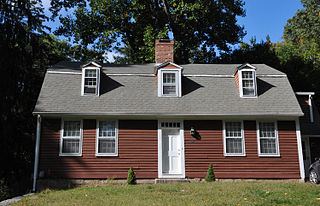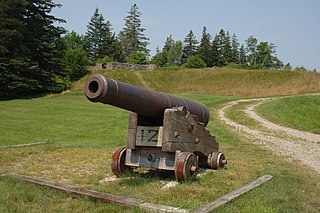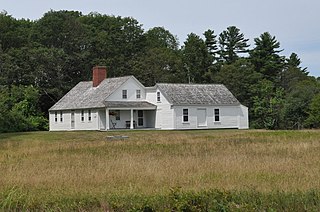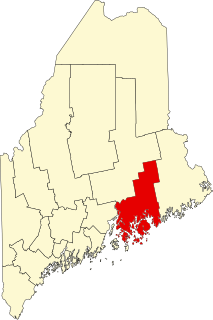
Brooksville is a town on Penobscot Bay in Hancock County, Maine, United States. As of the 2010 census, the town population was 934. It contains the villages of North Brooksville, South Brooksville, West Brooksville, Brooksville Corner, and Harborside.

The Penobscot Expedition was a 44-ship American naval task force mounted during the Revolutionary War by the Provincial Congress of the Province of Massachusetts Bay. The flotilla of 19 warships and 25 smaller support vessels sailed from Boston on July 19, 1779 for the upper Penobscot Bay in the District of Maine carrying a ground expeditionary force of more than 1,000 colonial Marines and militiamen. Also included was a 100-man artillery detachment under the command of Lt. Colonel Paul Revere. The Expedition's goal was to reclaim control of what is now mid-coast Maine from the British who had seized it a month earlier and renamed it New Ireland. It was the largest American naval expedition of the war. The fighting took place both on land and at sea in and around the mouth of the Penobscot and Bagaduce Rivers at what is today Castine, Maine over a period of three weeks in July and August of 1779. One of its greatest victories of the war for the British, the Expedition was also the United States' worst naval defeat until Pearl Harbor 162 years later in 1941.

The Pentagoet Archeological District is a National Historic Landmark District located at the southern edge of the Bagaduce Peninsula in Castine, Maine. It is the site of Fort Pentagoet, a 17th-century fortified trading post established by fur traders of French Acadia. From 1635 to 1654 this site was a center of trade with the local Abenaki, and marked the effective western border of Acadia with New England. From 1654 to 1670 the site was under English control, after which it was returned to France by the Treaty of Breda. The fort was destroyed in 1674 by Dutch raiders. The site was designated a National Historic Landmark in 1993. It is now a public park.

The Perkins-Bill House is a historic house at 1040 Long Cove Road in the Gales Ferry section of Ledyard, Connecticut. Built circa 1775 by Solomon Perkins, Sr., it is locally significant as a well-preserved gambrel-roofed Cape of the period, and for the role played by Perkins, his son Solomon, Jr., and Benjamin Bill, Jr., the house's next owner, in the American Revolutionary War. All three were defenders of the fort in Groton that was attacked by British forces under the overall command of Benedict Arnold in the 1781 Battle of Groton Heights. The house was listed on the National Register of Historic Places in 2000.

Defence was an American Revolutionary War privateer that was part of the 1779 Penobscot Expedition, during the American Revolutionary War. A brigantine, she was built that year in Beverly, Massachusetts, and was scuttled near Stockton Springs, Maine in the later stages of the expedition. The wreck site was excavated in the 1970s, and was listed on the National Register of Historic Places in 1975.

Fort George was a palisaded earthwork fort built in 1779 by Great Britain during the American Revolutionary War in Castine, Maine. Located at a high point on the Bagaduce Peninsula, the fort was built as part of an initiative by the British to establish a new colony called New Ireland. It was the principal site of the British defense during the Massachusetts-organized Penobscot Expedition, a disastrous attempt in July and August of 1779 to retake Castine in response to the British move. The British re-occupied Castine in the War of 1812 from September 1814 to April 1815, rebuilding Fort George and establishing smaller forts around it, again creating the New Ireland colony. The remains of the fort, now little more than its earthworks, are part of a state-owned and town-maintained park.

The Tarr–Eaton House, also known as Tarr–Eaton–Hackett House, is an historic house at 906 Harpswell Neck Road in Harpswell, Maine. Built before 1783 and enlarged about 1840, it is a well-preserved 18th-century Cape with added Greek Revival features, and one of Harpswell's few surviving pre-Revolutionary War buildings. It was listed on the National Register of Historic Places in 2001.

Castine is a census-designated place (CDP) in the town of Castine in Hancock County, Maine, United States. The CDP population was 1,029 at the 2010 census, out of 1,366 people in the town as a whole.

The Castine Historic District encompasses the entire southern tip of the peninsula on which the town of Castine, Maine is located. Covering about 1,800 acres (730 ha), this area was a center of colonial conflicts dating to the early 17th century, and was the site of military action during the American Revolutionary War and the War of 1812. Bypassed by the railroads, it has retained a village feel reminiscent of the early 19th century. It was listed on the National Register of Historic Places in 1973.

State Route 199 (SR 199) is part of Maine's system of numbered state highways, located in Hancock County. The route is almost completely within the town of Penobscot except for its southernmost 0.14 miles (0.23 km) near its terminus at SR 166A, which is in Castine. The route is 10.44 miles (16.80 km) long.

The John Perkins House is a historic house museum on the grounds of the Wilson Museum at 120 Perkins Street in Castine, Maine. Built in 1765 on Court Street, it is one of the oldest houses in Castine, and a well-preserved example of Georgian architecture; it was moved to its present location in 1968-69 and restored. The house was listed on the National Register of Historic Places in 1969. It is open for tours on a limited basis during July and August.
The Von Mach Site is an archaeological site in Brooksville, Maine. Located on the south bank of the Bagaduce River opposite Castine, the principal feature of the site is a large shell midden, yielding evidence of a long period of human habitation. When excavated by pioneering Maine archaeologist Warren K. Moorehead in the 1920s, he described one of the cermaic finds at this site among the most finely decorated he had found anywhere on the New England coast. The site was listed on the National Register of Historic Places in 1989.

The Penobscot Expedition Site is a submerged historic archaeological area in the waters of the Penobscot River between Bangor and Brewer, Maine. The area is the site of the abandonment and loss of many vessels in the disastrous 1779 Penobscot Expedition, an American Revolutionary War expedition in which the rebellious Americans lost an entire fleet of ships. The site was listed on the National Register of Historic Places in 1973; it has been of interest to salvagers and later archaeologists since the early 19th century.

The Jabez Knowlton Store is a historic commercial building on Maine State Route 9 in Newburgh, Maine. Built in 1839, it is a well-preserved example of commercial Greek Revival architecture in a rural context. It is more significant for its well-preserved collection of goods dating to the early 20th century, preserved by the Knowlton family after the store's last proprietor died in 1910. The property, open by appointment as a museum, was listed on the National Register of Historic Places in 1978.

Chimney Farm is a historic farm property at 617 East Neck Road in Nobleboro, Maine. The heart of the farm is an early 19th-century farmhouse, which was from 1931 to their respective deaths home to the writers Henry Beston (1888–1968) and Elizabeth Coatsworth (1893–1986). Both were prominent regional award-winning writers, and the farm property played a prominent role on some of their writings. It was listed on the National Register of Historic Places in 2007.

The Heal Family House, also known as the Washington Heal House, is a historic house on Maine State Route 127 in Georgetown, Maine. Built about 1798, it is one of a small number of surviving Federal period houses in the rural community. It was owned for more than 100 years by members of the Heal family. It was listed on the National Register of Historic Places in 1994.

The Murch Family House is a historic house on Calderwood Neck in Vinalhaven, Maine. Built in 1855, it is the only granite house in a community long known for its granite quarries, and one of a relatively small number of documented stone houses in the state. It was listed on the National Register of Historic Places in 1993.

State Route 175 (SR 175) is a state highway entirely in Hancock County, Maine that travels for 37.8 miles (60.8 km). The shape of the route is an unusual U-shape and travels along the peninsula surrounded by Blue Hill Bay, Eggemoggin Reach, and Bagaduce River. The route is signed as north-south but has two northern termini: at State Routes 15, 172, and 176 in Blue Hill, and at SR 166 in Penobscot. The transition point of the directional signage occurs about 2 1⁄2 miles (4.0 km) from the Blue Hill terminus.





















